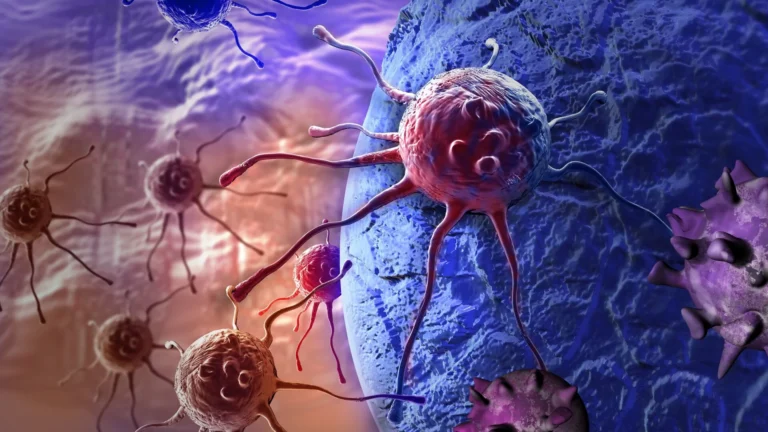Cancer is a group of diseases in which abnormal cells grow uncontrollably, invade nearby tissues, and can spread (metastasize) to other parts of the body. It develops when DNA (genetic material) becomes damaged due to genetic predisposition, environmental factors, or lifestyle influences, leading to disrupted cell growth regulation.
What is Cancer?
Cell growth and division (proliferation) are natural processes that occur in the body to replace damaged or dead cells. In healthy tissues, this process is tightly controlled. However, when mutations occur in DNA, the balance between cell growth and cell death is disrupted, potentially leading to cancer.
There are two main types of tumors:
- Benign tumors – Non-cancerous growths that do not spread and are rarely life-threatening.
- Malignant tumors – Cancerous growths that can invade other tissues and spread to distant organs.
Common Types of Cancer
- Breast cancer
- Lung cancer
- Prostate cancer
- Colorectal cancer
- Skin cancer (melanoma and non-melanoma)
- Leukemia and lymphoma
Causes and Risk Factors
Cancer can develop due to a combination of genetic, environmental, and lifestyle factors. Common risk factors include:
- Genetic mutations or family history of cancer
- Smoking and tobacco use
- Excessive alcohol consumption
- Prolonged sun exposure without protection
- Obesity and poor diet
- Chronic infections (e.g., HPV, hepatitis B/C)
- Exposure to radiation or harmful chemicals
Signs and Symptoms
Symptoms of cancer can vary depending on the type and stage, but they are often grouped into three categories:
- Local symptoms: Unusual swelling or lumps, bleeding, ulceration, or jaundice.
- Symptoms of metastasis: Enlarged lymph nodes, persistent cough, coughing blood, enlarged liver, bone pain or fractures, and neurological changes.
- Systemic symptoms: Unexplained weight loss, fatigue, loss of appetite, excessive night sweats, anemia, and hormonal imbalances.
Note: Many of these symptoms can also be caused by conditions unrelated to cancer. Diagnosis should be confirmed by a healthcare professional.
How Cancer is Diagnosed
Diagnosis typically involves:
- Physical examination
- Blood and laboratory tests
- Imaging studies (MRI, CT scan, ultrasound)
- Biopsy of suspicious tissue
Treatment Options
Treatment depends on the type, location, and stage of cancer, as well as the patient’s overall health. Common approaches include:
- Surgery to remove tumors
- Chemotherapy
- Radiation therapy
- Immunotherapy
- Targeted drug therapy
- Hormone therapy (for hormone-sensitive cancers)
Prevention and Risk Reduction
While not all cancers can be prevented, risk can be reduced by:
- Maintaining a healthy diet rich in fruits and vegetables
- Engaging in regular physical activity
- Avoiding smoking and limiting alcohol intake
- Using sun protection
- Getting vaccinated against HPV and hepatitis B
- Scheduling regular medical check-ups and cancer screenings
When to See a Doctor
If you experience persistent or unexplained symptoms such as lumps, changes in skin appearance, chronic fatigue, or unexplained weight loss, consult a healthcare provider promptly for evaluation.
Additional Resources
For more detailed information, visit the National Cancer Institute.
Frequently Asked Questions
What is the most common cancer? — Breast cancer is the most commonly diagnosed cancer worldwide, followed by lung and colorectal cancers.
Can cancer be cured? — Many cancers can be successfully treated if detected early, but outcomes vary depending on the type and stage.
How often should I get screened? — Screening frequency depends on your age, gender, and risk factors. Discuss personalized screening schedules with your doctor.


1 Comment
I am really grateful to the owner of this web site who has shared this great post at here.